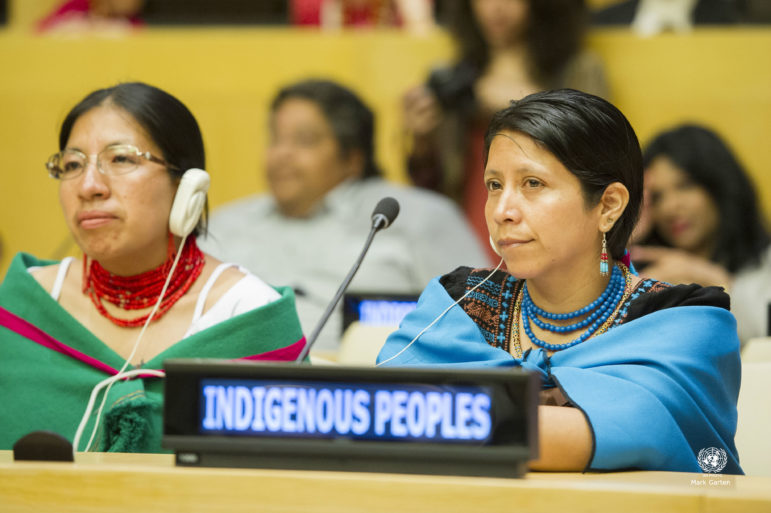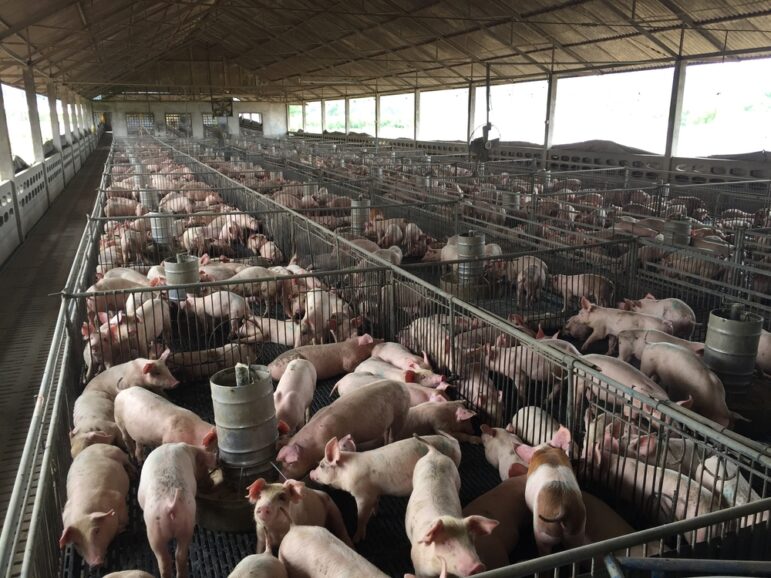

Image: Shutterstock
Guide Resource
GIJN/NAJA Guide for Indigenous Investigative Journalists
Chapter Guide Resource
Data Journalism on Indigenous Communities
Chapter Guide Resource
Land Ownership: Community Rights Under Threat
Chapter Guide Resource
Investigating Criminal Justice
Chapter Guide Resource
Exposing Exploitation and Corruption
Chapter Guide Resource
Covering the Climate Crisis
Chapter Guide Resource
Investigating Murdered or Missing Persons
Chapter Guide Resource
Indigenous Data Sovereignty
Chapter Guide Resource
Getting Documents, Dealing with Whistleblowers, and Staying Safe
Chapter Guide Resource
GIJC23 Indigenous Investigations Webinar
Exploitation of natural resources on Indigenous lands occurs in many ways, according to a substantial body of investigative work and official reports involving countries around the world.
This GIJN/NAJA resource covers techniques for investigating corporations, contracts, development projects, and payments by extractive industries to governments.
The mechanisms by which corporations acquire their desired resources are varied, as are the types of resources: minerals, timber, oil, agribusiness, energy, infrastructure, and more.
“Industry’s extraction of natural resources routinely inflicts acute human rights violations on racial and ethnic minorities, Indigenous peoples, and other marginalized groups,” concluded a comprehensive 2019 report by the UN’s human rights expert on racism. The economic effects on Indigenous populations are disproportionate, too, since their traditional lands are heavily targeted.
In Peru, for example, mining concessions affect almost half of the territory of peasant communities and 75% of the Peruvian Amazon is covered by oil and gas concessions, according to the Database of Indigenous of Original Peoples by the International Work Group for Indigenous Affairs.
For Indigenous journalists, one reporting advantage may be in their access to affected communities, enabling them to obtain facts and testimony to tell under-reported stories about exploitation and corruption.

Photo: Shutterstock
Journalism Case Studies
The variety of journalism on this topic is enormous, as indicated by these examples.
In 2019, Mongabay and The Gecko Project published the report What We Learned from Two Years of Investigating Corrupt Land Deals in Indonesia. Their series Indonesia for Sale revealed that district chiefs systematically exploited their control over land amid a near-complete lack of oversight to make millions of dollars by selling permits to major plantation firms. Ghosts in the Machine: The Land Deals Behind the Downfall of Indonesia’s Top Judge won an award in the 2019 Society of Environmental Journalists contest.
In India, for example, government approval for iron mining that resulted in the cutting of forests considered sacred allegedly had the consent from the local community, but an investigation by Scroll.in found that petition signatures were forged.
There are ramifications from mining, deforestation, drilling, large-scale agriculture, etc. Journalists may usefully explore consequences such as environmental degradation, loss of communal lands, eviction of residents, and treatment of workers, and, inversely, perhaps the enrichment of individuals and corporations.
An investigation by Mongabay found that isolated Indigenous groups in Venezuela such as the Hoti, Yanomami, and Piaroa are under threat on several fronts from legal and illegal mining.
The investigation was part of a series of stories, called Indigenous Peoples and Conservation.
Tossed Aside in the ‘White Gold’ Rush is a 2016 Washington Post probe subtitled, “Indigenous people are left poor as tech world takes lithium from under their feet.”
Human rights violations are part of the story, too.
Murder, Rape and Claims of Contamination at a Tanzanian Goldmine by The Guardian covers abuses that affected a workforce that included many persons from the Kuria Indigenous community.
Journalists have sought to hold companies accountable.
A Damaging Mining Boom is a 2015 probe by the International Consortium of Investigative Journalism (ICIJ) into the track record of Australian companies seeking wealth from Africa’s minerals. The ICIJ and journalists from more than 10 countries looked at thousands of documents to compile information, often deeply buried inside annual and quarterly reports, license registries, etc.
Timberleaks in 2019 found logs originating from the Central African Republic, the Democratic Republic of Congo, Liberia, and elsewhere “linked to firms implicated in illegal deforestation, bribing governments, and environmental abuses.”
Illegal Deforestation Monitor in 2019 published articles such as: Are KitKat Sales Helping Line the Pockets of a Man Who Bribed Indonesia’s Top Judge? and Bad Beef: UK Supermarkets Feed Illegal Deforestation Fears as Corned Beef Imports from Corruption-hit Brazilian Firm Persist.
NewsNow Finland reported Investigation: Neste Still Buying Palm Oil from Mills Caught in Illegal Rainforest Harvests.
Extractive Industries and Development
Tracking payments from industries to governments is a key reporting tool. National information is key, but some helpful international resources exist. For extractive industries, see:

Illustration: Creative Commons
EITI Country Reports: Reporting through the Extractive Industries Transparency Initiative resulted in a collection of data regarding revenues paid by companies and received by governments for the 37 countries that are part of the EITI.
Resource Projects: This website from the Natural Resources Governance Institute (NRGI) has data on payments made by companies for extracting oil, gas, and mining resources around the world.
The National Oil Company Database: This database compiles information on the production, revenues, and performance of 71 national oil companies.
Open Oil: This site has a database of over 2 million public domain documents filed by oil and gas and mining companies to financial regulators around the world, plus some good educational materials.
For more on this topic see the GIJN resource Covering the Extractive Industries, which includes more data sources and some guides to covering the area.
Here are a few useful handbooks:
Twelve Red Flags: Corruption Risks in the Award of Extractive Sector Licenses and Contracts. This handbook, written by two NRGI staffers, suggests things to watch for, such as a winning bid by a seemingly unqualified company. (Available in English, French, and Indonesian.)
Thomson Reuters Foundation’s Oil and Gas Reporting Handbook. A comprehensive guide that explains some of the more complicated aspects of the oil and gas industry to help journalists report on the sector in a more effective and informed manner.
Finding the Missing Millions. A 2018 Global Witness handbook for using extractive companies’ revenue disclosures to hold governments and industries accountable.
Dozens of NGOs pay attention to specific industries or areas. So searches on products such as palm oil, or general areas, such as logging, may turn up valuable information and potential sources.

Photo: Shutterstock
Development Projects
Development projects such as dams and highways have also negatively affected Indigenous peoples.
For example, a 2019 report by the Oakland Institute in the United States describes the impacts of a dam project and a sugarcane plantation project in the Lower Omo River in southwest Ethiopia, home to eight different tribes with a population of about 200,000. The dam ended the annual floods, with harmful effects on farmers’ crops.
An international perspective on the dams issue was provided by Colin Samson, a sociology professor at the University of Essex in Canada, in a 2016 article, How a Controversial Dam Tramples on Rights of Canada’s Indigenous Innu People.
Investigating such projects involves looking deeply into financing, which often involves an international financial organization such as the World Bank or the Asian Development Institution. The country pages on their websites contain reports on the projects, including on the economic, environmental, and social consequences.
Finding Corporate Information
Investigating corporations is key to reporting in this area.
OpenCorporates is an open data source for information on more than 150 million companies. The information is sourced from national business registries. The database can provide such things as a company’s incorporation date, its registered addresses, and the names of directors and officers. It can show connections between companies. It is also developing a database of corporate events. Follow the blog for updates and examples of how the media uses OpenCorporates. Journalists, NGOs, academics, and other public benefit users can apply for a free public-benefit API key.
Investigative Dashboard, sponsored by the Organized Crime and Corruption Reporting Project (OCCRP), has millions of relevant items from data sources around the world, including many about corporations. Search for documents beginning here (click “search” for advanced search options). There is a guide to company registries in 38 countries here.
Not every database, including leaked material, is searchable by the public. However, journalists can request access by registering. They can also make requests for free research help, including searches of commercial databases to which OCCRP subscribes.
Here is a good introduction to using OCCRP’s resources. Read a GIJN article with seven tips on using the database, such as an alerts feature so you will always be notified of new developments regarding the individuals or companies you are investigating. Also see this user manual for search tips and more, or this Elastic post for an even deeper look at string queries.
The ICIJ Offshore Leaks Database is a database of corporate information based on leaked documents about nearly 785,000 offshore companies and trusts.
The database can be searched by name, country, jurisdiction, or companies and addresses connected to offshore entities. ICIJ’s archive of stories based on the Panama Papers makes for good reading. Also see Beyond Panama: Unlocking the World’s Secrecy Jurisdictions. See three tips on using the databases.
New on the scene is Sayari, a US research firm that in 2018 launched a multi-faceted database that “covers more emerging, frontier, and offshore markets.” Sayari is a subscription service that costs around $1,000 a month, but a 30-day free trial is available and the company is interested in working with journalists.
There are many private databases about corporations, most of which require a subscription for the best information. Free access may be possible through public and university libraries.
The cost of using commercial databases may be worthwhile and some companies will provide lower rates for journalists. One long-established database is D&B Hoovers. Its free website offers capsule descriptions of thousands of companies based in the United States and abroad. More detailed descriptions are available on the subscription service Nexis.
Many governments require corporations to register, but soft rules often mean they file minimal and misleading information. The Commercial-Register is a listing of national registries maintained by Swiss researchers.
For more, see the GIJN resource Researching Corporations and Their Owners.
Following the path of goods to market is also a key investigatory process. Local producers, farmers, miners, etc. are often at the rough end of a supply chain, getting little pay and working in dangerous conditions.
Datasets such as Panjiva reveal imports and exports to help identify end purchasers. Panjiva is a user-friendly international database. Complimentary access is possible for journalists on a case-by-case basis; contact pressinquiries.mi@spglobal.com.
See the GIJN resource Investigating the Supply Chain.
Reporting on Contracts
International groups that advocate for open contracting reform also have educational materials, work with national groups, and will consult with journalists.
The Open Contracting Partnership is a major NGO focused mainly on encouraging more transparency in national contracting. It also has information on using contracting data. Among its features:
- The Idiot’s Guide to Looting Public Procurement to Get Rich Quick. Funny title, but it is actually a good overview of where to look for fraud.
- Red flags for integrity: Giving the green light to open data solutions is another guide on finding corruption in contracting.
- A video from 2019 provides a nice overview on contracting.
- Community Web Meeting: Media Use Cases for Open Contracting Data (2014).
- How journalists in Bulgaria are using data to investigate abuse of EU funds in procurement (2018).
The open contracts program of the Dutch philanthropic organization Hivos has supported training. It helped the Tagbanuas, a community living in the municipality of Narra in the Philippines, to investigate how much it should receive from a mining company that was obligated by law to pay 1% of its profits to the community. See story here.
A related topic is how government purchasing rules do or do not benefit Indigenous contractors. For example: It’s Time We Moved the Goalposts on Indigenous Policies, So They Reflect Indigenous Value is a 2019 piece by The Conversation examining who benefits from Australian government programs intended to get more government contracts to Indigenous peoples.
White US business owners in 18 states have been awarded more than $300 million under federal minority contracting programs since 2000 by making unsubstantiated claims of being members of three unrecognized Cherokee tribes, according to the Los Angeles Times.

















